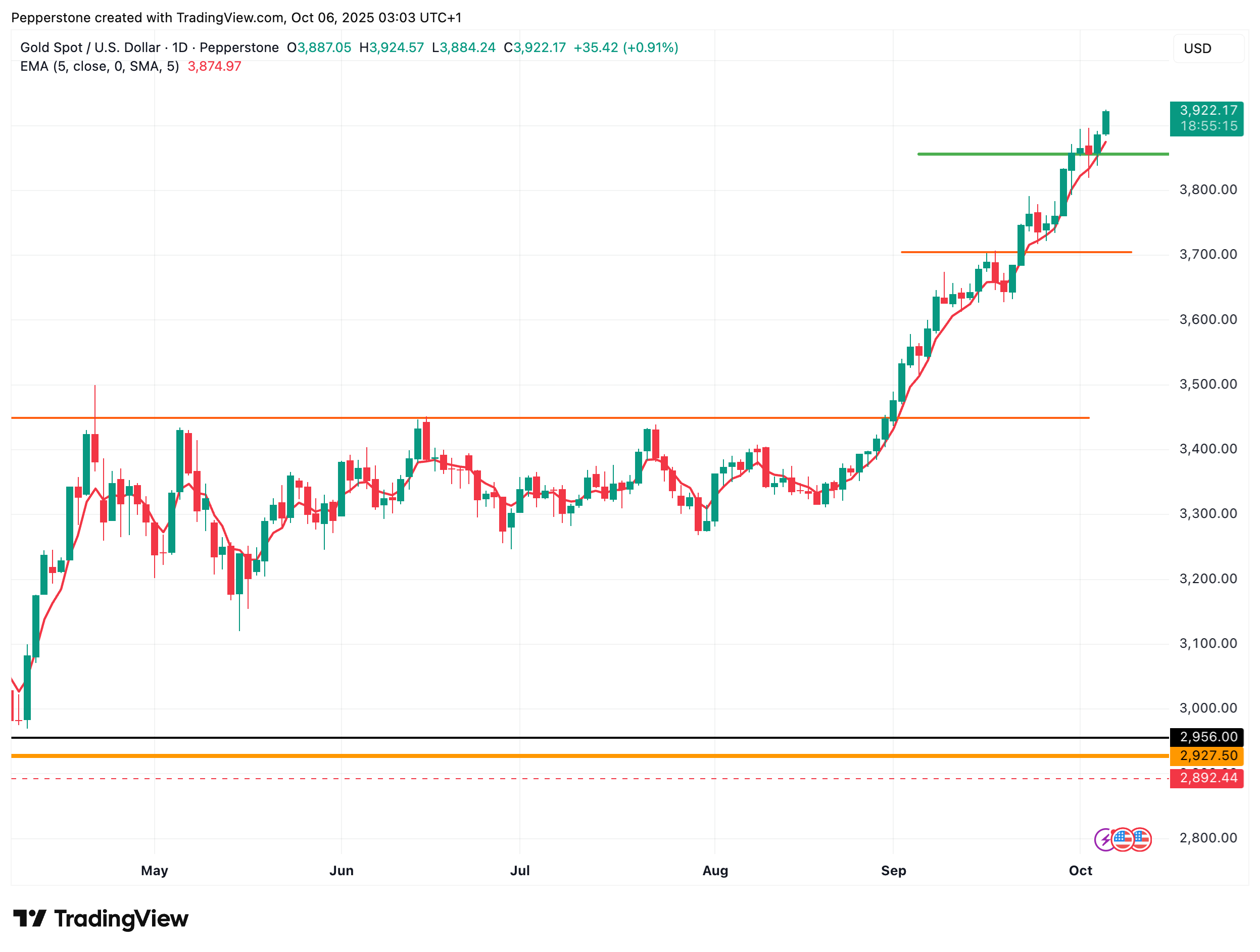Spread bets and CFDs are complex instruments and come with a high risk of losing money rapidly due to leverage. 72% of retail investor accounts lose money when trading spread bets and CFDs with this provider. You should consider whether you understand how spread bets and CFDs work, and whether you can afford to take the high risk of losing your money.
- English (UK)
Gold Outlook: Bulls Break Above $3,900 as U.S. Government Shutdown Unfolds
.jpg)
Over the past week, gold has maintained a strong upward trajectory. On Monday morning, prices successfully broke above $3,900, repeatedly setting new record highs. The rally has been fueled by uncertainty surrounding the U.S. government shutdown and the ongoing global "de-dollarization" trend, while technical indicators suggest short-term retracement pressures may emerge.
This week, traders will closely watch the progress of the government shutdown and speeches from several Fed officials, both of which could influence gold's near-term movements.
Technical Observation: Holding Above $3,900 Is Key
Looking at the XAUUSD daily chart, gold’s upward momentum remains robust. Even with brief pullbacks, prices have stayed above the 5-day EMA, marking a seventh consecutive week of gains. The recent break above $3,900 comes less than ten days after first surpassing $3,800. Weekly and monthly charts also show a clear bullish alignment, indicating that the overall trend remains strong.

The market is now focused on whether gold can hold above the $3,900 psychological level. Sustaining this level would confirm the validity of the breakout and set the stage for a potential challenge of $4,000. On the downside, $3,855 remains a key support; a breach could intensify short-term retracement pressures and potentially push prices back toward $3,800.
Government Shutdown Boosts Gold’s Safe-Haven Appeal
One of the major drivers behind gold's rally is undoubtedly the U.S. government shutdown. The closure has directly impacted economic data releases, with the Friday nonfarm payroll report delayed. This report is a critical gauge of U.S. labor market cooling and the Fed’s rate-cutting pace. Its absence has created a “data vacuum,” enhancing gold’s appeal as a safe haven.
In the absence of the nonfarm data, markets have turned to alternative indicators. Last week, ADP data showed a decline of 32,000 jobs in September, while the ISM Services PMI employment index has contracted for four consecutive months. These signals reinforce expectations for Fed rate cuts: the market has fully priced in a cut in October, and the probability of a December cut has risen to around 90%, supporting gold.
Political uncertainty further strengthens gold’s attraction. Neither party has demonstrated clear cross-party support for government funding proposals, leaving the shutdown stalemate unresolved in the short term. According to the latest data from prediction market Kalshi, bets on a prolonged shutdown have surged: the probability of a shutdown lasting over 10 days is 70%, and over 15 days, 46%.
The uncertainty from the shutdown, combined with concerns about long-term inflation and debt depreciation from the U.S.’s high fiscal deficit, plus earlier tariff frictions, has put pressure on the dollar’s credibility. Against this backdrop, central banks are steadily increasing their gold reserves, using “de-dollarization” to hedge risks, which in turn drives capital into the gold market and supports prices.
From a trading standpoint, the longer the U.S. government shutdown drags on, the more attractive gold becomes as a safe-haven asset. If the shutdown is short-lived, affected government workers would receive back pay and economic damage would be limited, providing moderate support for gold. However, if the stalemate extends, safe-haven demand could intensify, giving gold more pronounced upward momentum.
Buying the Dips Still Favored, With Some Risks
Overall, gold remains supported by safe-haven flows and central bank de-dollarization. As the U.S. government shutdown drags on, concerns about its impact on economic growth and policy uncertainty continue to drive funds from risk assets into gold. Meanwhile, rate-cut expectations reduce the opportunity cost of holding non-yielding gold, further enhancing its appeal. In this environment, pullback buying remains the dominant trading strategy.
Despite the bullish outlook, traders should stay vigilant, as the following factors could trigger a short-term correction:
- Sudden End to the Government Shutdown: If the stalemate resolves quickly, risk-off sentiment could diminish, pressuring gold prices.
- Hawkish Fed Signals: With 21 Fed officials scheduled to speak this week and limited major economic data, these speeches could heavily influence the market. Hawkish hints suggesting slower rate cuts or limited policy transparency could pressure gold.
- Key Support Breach: A drop below $3,855 could indicate a short-term top has formed.
Due to the shutdown, major U.S. economic data releases will be limited this week. Last week’s delayed nonfarm report is a key reference for the Fed’s policy decisions. Once the government reopens, the report is likely to be published quickly, improving policy visibility and potentially putting short-term pressure on gold.
The material provided here has not been prepared in accordance with legal requirements designed to promote the independence of investment research and as such is considered to be a marketing communication. Whilst it is not subject to any prohibition on dealing ahead of the dissemination of investment research we will not seek to take any advantage before providing it to our clients.
Pepperstone doesn’t represent that the material provided here is accurate, current or complete, and therefore shouldn’t be relied upon as such. The information, whether from a third party or not, isn’t to be considered as a recommendation; or an offer to buy or sell; or the solicitation of an offer to buy or sell any security, financial product or instrument; or to participate in any particular trading strategy. It does not take into account readers’ financial situation or investment objectives. We advise any readers of this content to seek their own advice. Without the approval of Pepperstone, reproduction or redistribution of this information isn’t permitted.